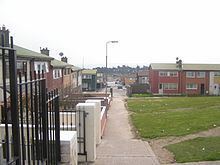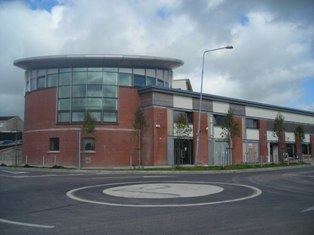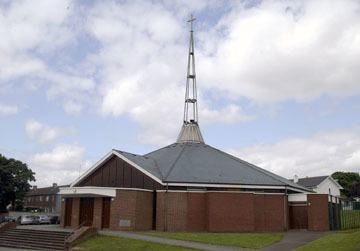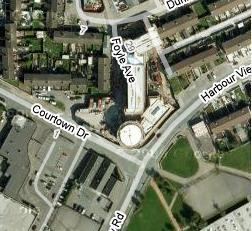 | ||
Joy in the hood knocknaheeny
Knocknaheeny (Irish: Cnoc na hAoine, Hill of Friday) is a working class suburb in Cork city, located north of the River Lee on hills overlooking the city. Translated from Irish, the name means Hill of Friday, thought by some to reference the hill Jesus Christ was crucified on, although this is open to being just general common knowledge between children in particular, in the area's youth. The area consists mainly of various estates, with terraced Council housing.
Contents
- Joy in the hood knocknaheeny
- Spin around hollyhill knocknaheeny in the rain
- History
- Schools
- Sport
- Knocknaheeny Crest
- Transport
- Famous People from the Area
- References

Apple's European base is located in the area between Knocknaheeny and Hollyhill and being a call centre, it employs a large number of Europeans and Non-EU staff, however, the knock-on effect to local businesses and local economy is generally a positive one.

Spin around hollyhill knocknaheeny in the rain
History

Knocknaheeny is a relatively new community: today some 4,500 people live in the area, but up until the early 1970s it consisted of rolling countryside bordering on the Gurranabraher, Churchfield and Farranree areas. Cork City Council, known then as Cork Corporation, began to house and rehouse people who lived in slightly older areas of the city, mainly those who grew up in neighbouring Churchfield, Farannree, or Gurranabraher and who wished to be closer to their families. In the late 1970s and 1980s, Knocknaheeny had a very young population. The local primary school Scoil Mhuire ar Cnoc na hAoine (St. Mary's on the Hill), was granted extensions to the school to cope with over-populated classrooms. Scoil Mhic Shuibhne (now Terence McSwiney Community College) was opened in 1979, the first VEC (Vocational Educational Committee) mixed school. By the end of the 1980s and into the 1990s, the school had a population of over 800 students. But like the other local schools, has seen a drop in numbers to well under half of that, mainly due to changing demographics and the Celtic tiger enabling many families to relocate and purchase homes in newer estates in villages and towns in the Cork county region.

Unemployment was high, in particular in the early to mid-1980s, due to the closure of many local industries, including Sunbeam, in Blackpool. Opportunities were few for many young people to further their education at universities at that time, however there was a much greater success rate for those attending post-leaving certificate courses, and attending Regional Technical College, Cork (now known as Cork Institute of Technology). The introduction of programmes in the 1990s enabled more students to have a greater opportunity to attend university and worked with great success. Many local students who didn't attend university or the third-level generally returned in later years to achieve that, as all Irish colleges and universities facilitate mature students also with great success.

The area suffered from negative press, due to social problems and the problem of joyriding, and people that grew up in the area at this time, often claimed that their applications for jobs were refused because of where they were from, and people from outside the area generally had misconceptions of them. There was a high turnover of tenants in the area also, and a great many people moved in and out of the area. Many of the original families that moved in at the beginning, still reside there.
Cattle grazed on what is now Harbour View Road and a windmill stood on the site of Killala Gardens. The older townlands were named after plants at the time for instance Knocknaheeny (the Hill of the Friday? / Rushes), Knocknacullen (Hill of Holly), Knockfree (the Hill of Heather) and Shanakiel (Old Wood or Foxes Wood).
In 1862 Griffith's Land Valuation Survey reported that fifteen families formed the lands of Knocknaheeny, Knocknacullen. They paid rent to the Lord of Cork. One family, Forrest, still farms land near to Clogheen. Having constructed the road system which serves the area the corporation had to name the terraces and avenues of modern Knocknaheeney. They decided to name the individual roads and streets after harbours and coastal areas around the country.
Many of the houses in Knocknaheeny have run into neglect. However over the past few years Cork City Council have made efforts to improve this situation and the area appears to be going through a revival. Development and improvement is now visible all over the area with a new Town Centre currently under construction on Harbour View Road. Residential areas are also popping up with housing now erected at the Reservoir (Rezza) stretching down to Nash's Boreen and the new affordable housing located on Hollyhill Lane and the Shanakiel Development at the top of the Blarney Road.
Much work was put into keeping the houses up to standard, from the 1980s when the felt roof houses were changed to slate, and in the late 1980s where Gas was installed into the homes in order to heat the houses. In the 1990s the windows and doors of those who were tenants of Cork City Council were changed, and field areas and alleys that attracted anti-social behaviour, were blocked off and made an extension of a neighbouring garden, or houses where built in the green areas. However, it was felt by the council, according to local people, that money was being wasted in constantly upgrading and maintaining the area, so plans where put in place in recent years, to demolish the greater part of Knocknaheeny and rebuild it in phases. Locals were consulted on the plans, and there was some resistance and reluctance by many who felt that the council held no regard for the strong sense of community and ties that were built up over the years. There was also some questioning of the City Council's relationship with Apple Computers with some people wondering whether it was part of Apple's plans in expansion, wanting a new road built through where some houses stood, to accommodate them. Their subsequent plans to expand and be allowed to buy land that included part of a very old pilgrimage route and a newer section of a main road circling the outside of the neighbourhood were the reasons for such reservations. Nevertheless, 2014 saw the first phase of rehousing of all the people in that phase. So far those whose houses have to be demolished, both council and privately own/previously owned houses, have been rehoused in neighbouring areas. Those who had purchased their houses from the City and who haven't agreed to, have to wait for the alternative housing that the Council has offered. They usually have to remain in their homes in Knocknaheeny while the Council starts demolition around them.
Schools
Knocknaheeny's primary school is St. Mary's on the Hill, opened in 1981, and which admits both boys and girls. In its early years it was granted an extension to deal with the then large numbers of students. The Secondary School is Terence MacSwiney Community College (formerly Scoil mhic Shuibhne), which as previously mentioned above had approximately 800 students, and now houses, at its western end, a further education college now in existence for twelve years, now known as CityNorth College. There is also a presence of Barnados in the area since the early 2000s and The Family Centre that was set up by the local Daughters of Charity, in the area's infancy, in now under the guidelines of the Health Service Initiative since the early 2000s. The Family Centre runs a pre-school through the high-scope method and a creche. In the late 1970s and 1980s, there was a nursery school operating in Ardmore Avenue, but for various reasons, including lack of a teacher, building unsuitability and lower child population numbers, it had closed. The secondary school was home to the Cork City Council Library until it had to move across to a premises in the shopping centre across the road from it. A new building for the library was built on the school's ground and was opened in Mid 2015. Most of the secondary school's land has been build on to accommodate The Family Centre and other community-based ventures in recent years.
Sport
Over the years, there have been a variety of sports introduced into the area, with many staying. One example would be that of tennis, where there would be tennis classes given every summer weekly, to interested children. These classes took place on the tennis court of the secondary school, which has since been built on. Martial Arts clubs are another example of clubs that local people have joined. Because Knocknaheeny is in close proximity to other neighbourhoods, clubs that weren't in the immediate area were usually easily accessed. For many years, the area ran a very popular swimming club, with local volunteers ensured that the children and people who wanted to swim could do so. this was made easy by the location of the Cork (city) council's public swimming pool located in Churchfield, and many children started their lessons here and moved on to become lifeguards and sports & swimming tutors themselves. Soccer is a big part of the community, and local teams include Knocknaheeny Celtic Club and Grattan United. Other sporting activities in Knocknheeny include GAA sports of Hurling and Gaelic football. In 1943, St Vincent's Hurling and Football club was founded to promote Gaelic games in the Blarney Street and Sunday's Well area, and later expanded to encompass Knocknaheeney, Gurranabraher and Churchfield. Recent years have brought success at underage level with various teams winning at the premier and A grades. The highlight of this has been the winning of the Minor Premier County in 1998. Some of these players joined with members of other successful underage teams from the 1990s to help the club win its first intermediate football title in 2006 and has ensured that the club retained Senior status for the first time since the 1970s.
Knocknaheeny Crest
The Knocknaheeny Crest is blue and black in colour and has the Irish title Cnoc na hAoine which translates to Knocknaheeny. The Crest contains three images 1) Reservoir 2) Windmill 3) Swallow. The three stars represent Knocknaheeny, Hollyhill and Knocknacullen.
Transport
Knocknaheeny is served by two bus routes
Famous People from the Area
Mark Carroll - Athlete Denise O'Sullivan - Football/Soccer Tomás Mulcahy - Cork GAA player
